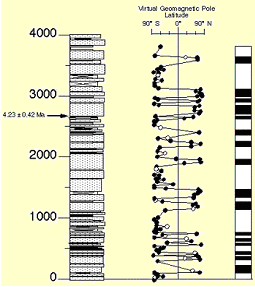Paleomagnetism
Palaeomagnetism
is responsible for determining the directions of the various components
that the remanent magnetisation of a rock may have, and which are
closely related both to the geological processes to which it has been
subjected since its formation and to the palaeodirection of the
geomagnetic field at different times in its history. Upon formation,
either by cooling from an original magma or by sedimentation and
subsequent lithification, a rock may acquire a remanent magnetisation
parallel to that of the geomagnetic field, as "seen" by the rock at
that instant. Subsequently, the rock may undergo various tectonic
displacements and deformations, which will cause the direction of its
primary remanent magnetisation to no longer coincide with that of the
geomagnetic field experienced by the rock. Similarly, processes of
metamorphism or metasomatism, or mere lightning strikes, may cause new
components to appear in the remanent magnetisation of the rock. These
new components, which will be called secondary components, can make the
primary component disappear totally or partially, in which case we will
have the coexistence of several components of the magnetisation with
different directions and with different degrees of overlapping. The
result is what is called Natural Remanent Magnetization (NRM).
By means of an appropriate treatment in the laboratory, either by
applying gradual increases in temperature or by subjecting the sample
to alternating magnetic fields of increasing maximum intensity, the NRM
of the rock is progressively destroyed and demagnetised. Since this
demagnetisation takes place step by step, measuring the NRM after each
step allows us to analyse which components made up the NRM of the
sample and their respective directions. With the spatial orientation
data taken when the rock sample was collected in the field, we can
restore the directions of the different components of the magnetisation
to the geographical context of the sampled rock outcrop. All this can
be complemented with the application of various field tests, such as
the fold test, the inversion test or the conglomerate test, which
provide us with valuable information about the age of the different
components of the NRM, always relative to the ages of the geological
processes being considered when applying the respective test (rock
folding, conglomerate formation, etc.).
All this information, properly contrasted or complemented
with geological and structural data, as well as with rock
magnetism experiments that allow to determine which minerals are the
NRM carriers, can provide important evidence about many aspects of the
geological history experienced by the rocks or about the behaviour of
the geomagnetic field in past times. Thus, among the applications of
palaeomagnetism are the following:
-Magnetostratigraphy.
The study of changes in the polarity of the geomagnetic field. It can
be used as a tool for stratigraphic correlation and relative dating.

-Palaeogeography.
Comparison of the position of the virtual palaeomagnetic poles
(determined from the NRM of rocks) for a given age with the geographic
poles allows, given the conditions that the geomagnetic field can be
described as that of an axial, geocentric dipole, to reconstruct the
distribution of the continents at that time, as well as the relative
movements experienced since then.
- Tectonic deformations.
Comparison of the NRM directions between rocks forming a relatively
stable part of a continental mass and rocks located in a deformed
region allows the geometry of these deformations to be reconstructed.
For example, it is possible to know the rotations of blocks around
vertical axes that occur in various continental margins subject to
deformation, as in the case of the Betic Chain.
Examples of Paleomagnetism works developed by the UCM Paleomagnetism Group:
Ruiz-Martínez, V.C.,
Torsvik, T. H., Van Hinsbergen, D. J. J., & Gaina, C. (2012),
“Earth at 200 Ma: Global palaeogeography refined from CAMP
palaeomagnetic data”. Earth and Planetary Science Letters, 331,
67-79; DOI: 10.1016/j.epsl.2012.03.008.
Palencia-Ortas, A., Ruiz-Martínez, V.C., Villalaín, J.J., Osete, M.L.,
Vegas, R., Touil, A., Hafid, A., McIntosh, G., van Hinsbergen, D.J.J.,
Torsvik, T.H. (2010), “A new 200 MA paleomagnetic pole for
Africa, and paleo-secular variation scatter from Central Atlantic
Magmatic Province (CAMP) intrusives in Morocco (Ighrem and Foum Zguid
dykes)”. Geophysical Journal International, 185, 1220-1234. DOI: 10.1111/j.1365-246X.2011.05017.x
Villasante-Marcos, V., Osete, M.L.,
Gervilla, F., García-Dueñas, V. (2003), "Paleomagnetic
study of the Ronda perioditites (Betic Cordillera, southern Spain).
Tectonophysics, 377, 119-141. PDF.
|



